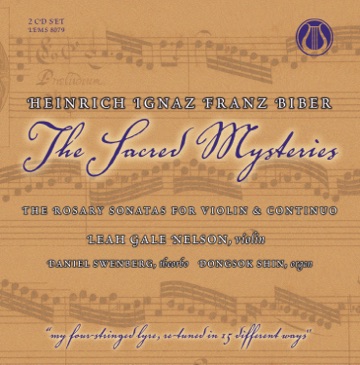"Her approach highlights the earthy vitality of the stories depicted..."
Heinrich Ignaz Franz Biber (1644-1704)
The Sacred Mysteries: The Rosary Sonatas for violin & continuo
with Daniel Swenberg, theorbo & Dongsok Shin, organ
Joyful – Sorrowful – Glorious
15 violin tunings – 16 evocative pieces
In this new Lyrichord recording, 21st century understanding of 17th century performance practice meets the formidable virtuosity of Biber’s violin writing. With the most extensive use of scordatura (re-tuning) in violin repertoire, each piece is given its own sound-world. Using a facsimile of the only surviving manuscript, gut strings, short bows, theorbo and chamber organ, these highly regarded period players offer a historical and impassioned approach to these improvisatory preludes, hymn-like sonatas, and spirited dance movements honoring the Mysteries of the Rosary. Listeners are moved by the power of this music, carrying us through joy, sorrow, and glory, reflecting scenes of life, death, and rebirth.
_________________________
“...my four-stringed lyre, re-tuned in 15 different ways..."
H.I.F. Biber
In these unique and demanding works of early virtuosic violin writing, the player is urged to coax a variety of unusual sounds and effects from the instrument. In scordatura, the virtuosity is heightened as the violin strings are tightened or relaxed, harmonies and resonances are opened or restricted, tensions rise and fall, enhancing the distinctive character of each evocative piece.
Inspired by the Mysteries of the Rosary, 17th century Bohemian-born H.I.F. Biber put quill to paper to create this exquisite collection that moves the soul and connects the spiritual with the temporal. Regardless of one’s faith, the listener cannot help but be moved by the power of these pieces.
_________________________
“The elegant realization of the continuo adds to the attractiveness of this version.”
“...an elegant and beautiful recording.”
"...like a diamond in a velvet case."


photo: Julie Lemberger
